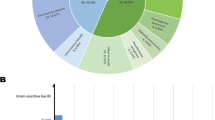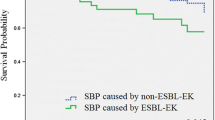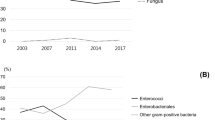Abstract
Background
Clinical outcomes associated with Gram-negative bacterial isolates with extended spectrum beta-lactamase (ESBL) in patients with biliary tract infection are largely unknown. The objective of the present study was to compare the demographics, risk factors, and clinical outcomes between patients with biliary tract infection caused by ESBL-producing and non-producing Klebsiella pneumoniae and Escherichia coli.
Methods
Between February 2005 and August 2010, we collected 159 cases with biliary tract infection caused by K. pneumoniae and E. coli identified by blood or bile cultures obtained before endoscopic or surgical treatment performed at our institution. We also retrospectively collected the data of patients’ demographic characteristics, co-morbid conditions, antimicrobial therapy, and clinical outcomes.
Results
Among the 159 strains isolated, 21 strains (13.2 %) were positive for phenotypical ESBL-test. Sepsis was more common in ESBL-positive strains, but did not reach statistical significance (23.8 % for ESBL-positive strains and 9.4 % for ESBL-negative strains, P = 0.066). Thirty-day mortality was significantly higher in ESBL-positive strains (3/21, 14.3 %) compared to ESBL-negative strains (4/138, 2.9 %, P = 0.049). However, there were no significant differences in overall survival between ESBL-positive and ESBL-negative strains. By multivariate analysis, inadequate antimicrobial therapy (HR 4.06, 95 % CI 1.08–16.46, P = 0.049) and sepsis (HR 6.54, 95 % CI 1.26–33.85, P = 0.025) were independent and significant predictors of 30-day mortality.
Conclusion
ESBL status of bacterial isolates for patients with biliary tract infection caused by K. pneumoniae and E. coli has clinical impact, especially on the short-term outcomes of those patients.



Similar content being viewed by others
Abbreviations
- ALP:
-
Alkaline phosphatase
- AUROC:
-
Area under receiver operating characteristics
- CBD:
-
Common bile duct
- CI:
-
Confidence interval
- CRP:
-
C-reactive protein
- ERCP:
-
Endoscopic retrograde cholangiopancreatography
- ESBL:
-
Extended spectrum beta-lactamase
- EST:
-
Endoscopic sphincterotomy
- HR:
-
Hazard ratio
- MIC:
-
Minimum inhibitory concentration
- PTBD:
-
Percutaneous transheaptic biliary drainage
- SD:
-
Standard deviation
- Spp.:
-
Species
- WBC:
-
White bold cell
References
Melzer M, Toner R, Lacey S, Bettany E, Rait G. Biliary tract infection and bacteraemia: presentation, structural abnormalities, causative organisms and clinical outcomes. Postgrad Med J. 2007;83:773–776.
Attasaranya S, Fogel EL, Lehman GA. Choledocholithiasis, ascending cholangitis, and gallstone pancreatitis. Med Clin N Am. 2008;92:925–960.
Claesson BE, Holmlud DE, Matzsch TW. Microflora of the gallbladder related to duration of acute cholecystitis. Surg Gynecol Obstet. 1986;162:531–535.
Shimada K, Noro T, Inamatsu T, Urayama K, Adachi K. Bacteriology of acute obstructive suppurative cholangitis of the aged. J Clin Microbiol. 1981;14:522–526.
Thompson JE Jr, Tompkin RK, Longmire WP Jr. Factors in management of acute cholangitis. Ann Surg. 1982;195:137–145.
Lee CC, Chang IJ, Lai YC, Chen SY, Chen SC. Epidemiology and prognostic determinants of patients with bacteraemic cholecystitis or cholangitis. Am J Gastroenterol. 2007;102:563–569.
Charlson ME, Pompei P, Ales KL, MacKenzie CR. A new method of classifying prognostic co-morbidity in longitudinal studies: development and validation. J Chron Dis. 1987;40:373–383.
Schwaber M, Navon-Venezia S, Kaye K, Ben-Ami R, Schwartz D, Carmeli Y. Clinical and economic impact of bacteremia with extended-spectrum-beta-actamase-producing Enterobacteriaceae. Antimicrob Agents Chemother. 2006;50:1257–1262.
Pfaller M, Segreti J. Overview of the epidemiological profile and laboratory detection of extended-spectrum β-lactamases. Clin Infect Dis. 2006;42:S153–S163.
Ramphal R, Ambrose PG. Extended-spectrum β-lactamases and clinical outcomes: current data. Clin Infect Dis. 2006;42:S164–S172.
Goossens H, Grabein B. Prevalence and antimicrobial susceptibility data for extended-spectrum β-lactamase- and AmpC-producing Enterobacteriaceae from the MYSTIC program in Europe and the United States (1997–2004). Diagn Microbiol Infect Dis. 2005;53:257–264.
Kaye K, Engemann J, Fraimow H, Abrutyn E. Pathogens resistant to antimicrobial agents: epidemiology, molecular mechanisms and clinical management. Infect Dis Clin N Am. 2004;18:467–511.
Clinical and Laboratory Standards Institute. Performance Standards for Antimicrobial Susceptibility Testing: Fifteenth Informational Supplement. M100S15. Wayne, PA, USA: Clinical and Laboratory Standards Institute; 2005.
Bush K. New beta-lactamases in gram-negative bacteria: diversity and impact on the selection of antimicrobial therapy. Clin Infect Dis. 2001;32:1085–1089.
Jacoby GA, Medeiros AA. More extended-spectrum beta-lactamases. Antimicrob Agents Chemother. 1991;35:1697–1704.
Cosgrove SE, Carmeli Y. The impact of antimicrobial resistance on health and economic outcomes. Clin Infect Dis. 2003;6:1433–1437.
Winokur PL, Canton R, Casellas JM, Leqakis N. Variations in the prevalence of strains expressing an extended-spectrum beta-lactamase phenotype and characterization of isolates from Europe, the Americas, and the Western Pacific region. Clin Infect Dis. 2001;32:S94–S103.
Spanu T, Sanguinetti M, Tumbarello M, et al. Evaluation of the new VITEK 2 extended-spectrum beta-lactamase (ESBL) test for rapid detection of ESBL production in Enterobacteriaceae isolates. J Clin Microbiol. 2006;44:3257–3262.
Tumbarello M, Spanu T, Sanguinetti M, et al. Bloodstream infections caused by extended spectrum-beta-lactamase-producing Klebsiella pneumoniae: risk factors, molecular epidemiology, and clinical outcome. Antimicrob Agents Chemother. 2006;50:498–504.
Tumbarello M, Sanguinetti M, Montuori E, et al. Predictors of mortality in patients with bloodstream infections caused by extended-spectrum-beta-lactamase-producing Enterobacteriaceae: importance of inadequate initial antimicrobial treatment. Antimicrob Agents Chemother. 2007;51:1987–1994.
Russell JA. Management of sepsis. N Engl J Med. 2006;355:1699–1713.
Canton R, Coque TM. The CTX-M beta-lactamase pandemic. Curr Opin Microbiol. 2006;9:466–475.
Schwaber MJ, Carmeli Y. Mortality and delay in effective therapy associated with extended-spectrum beta-lactamase production in Enterobacteriaceae bacteraemia: a systematic review and meta-analysis. J Antimicrob Chemother. 2007;60:913–920.
Anderson D, Engemann J, Harrell L, Carmeli Y, Reller LB, Kaye KS. Predictors of mortality in patients with bloodstream infection due to ceftazidime-resistant Klebsiella pneumoniae. Antimicrob Agents Chemother. 2006;5:1715–1720.
Rodriguez-Bano J, Navarro M, Romero L, et al. Bacteremia due to extended-spectrum beta-lactamase-producing Escherichia coli in the CTX-M era: a new clinical challenge. Clin Infect Dis. 2006;43:1407–1414.
Mezler M, Peterson I. Mortality following bacteraemic infection caused by extended spectrum beta-lactamase (ESBL) producing E. coli compared to non-ESBL producing E. coli. J Infect. 2007;55:254–259.
Conflict of interest
None.
Author information
Authors and Affiliations
Corresponding author
Rights and permissions
About this article
Cite this article
Kim, H.J., Park, J.H., Park, D.I. et al. Clinical Impact of Extended-Spectrum β-Lactamase-Producing Enterobacteriaceae in Patients with Biliary Tract Infection. Dig Dis Sci 58, 841–849 (2013). https://doi.org/10.1007/s10620-012-2398-7
Received:
Accepted:
Published:
Issue Date:
DOI: https://doi.org/10.1007/s10620-012-2398-7




